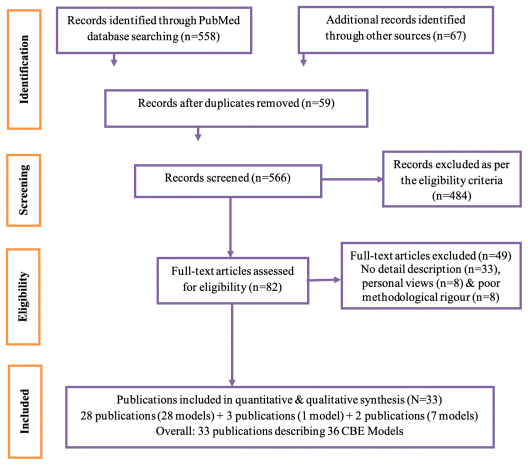
Figure 1 PRISMA-ScR Flow diagram depicting the final selection of studies included in the scoping review.
Vinayagamoorthy Venugopal 1 and Amol Dongre 2
1MD, Assistant Professor, Department of Community and Family Medicine, All India Institute of Medical Sciences Deoghar, Jharkhand, India
2MD, MPS, MHPE, Professor, Department of Community Medicine, Sri Manakula Vinayagar Medical College and Hospital, Puducherry, India
ABSTRACT
Background: Community-Based Medical Education (CBME) offers learning and training for medical students in the community setting. This scoping review aimed to describe the characteristics of the CBME curriculum delivered to medical undergraduates globally and to summarize the reported outcomes and impacts. Material and methods: A scoping review was carried out to address the study objectives, using the five-step methodological framework of H. Arksey and L. O’Malley. Published articles on CBME were retrieved using a systematically prebuilt search strategy applying Boolean operators. These search parameters were: no time limit; articles published other than on the medical profession; review articles; and non-English language articles which were excluded. PRISMA-ScR checklist was followed for reporting. Results: Of the 36 articles selected for scoping review, 17 (47.2%) were published between 2010 and 2020; 13 (36.1%) were from the South-East Asian region; and 18 (50%) were descriptive. Cognitive component on health issues was commonly taught (55.6%), 44.4% had CBME in multiple semesters, taught by the Community Medicine faculty, and each had a family survey as a teaching method. Taught in a rural setting among 83.4% of studies, 27.8% had CBME exposure throughout the course, and 47.2% were posted at primary health care. The most common formative and summative assessments were reflections/feedback, and presentations (19.4% each). Conclusions: The components of CBME curricula vary widely across the globe, shaped by the specific contexts of the universities and countries in which they are implemented. Recognizing and understanding these diverse approaches is essential for designing CBME curricula that are holistic, context-specific, and effectively tailored to meet local needs.
Keywords: scoping review; Medical students; curriculum; Community-based Medical education.
Date submitted: 27-July-2024
Email: Vinayagamoorthy Venugopal (drvinayagamoorthy@gmail.com)
This is an open access journal, and articles are distributed under the terms of the Creative Commons Attribution-Non Commercial-Share Alike 4.0 License, which allows others to remix, tweak, and build upon the work non-commercially, as long as appropriate credit is given and the new creations are licensed under the identical terms.
Citation: Venugopal V and Dongre A. Exploration of global community-based medical education curricula: a scoping review. Educ Health 2024;37:296-309
Online access: www.educationforhealthjournal.org
DOI: 10.62694/efh.2024.142
Published by The Network: Towards Unity for Health
The World Health Organization (WHO) strongly recommends that countries work to enhance their primary healthcare services to achieve global health equity. Despite this recommendation, many countries still face challenges in maintaining the availability and quality of such services, resulting in underserved populations.1 A Community-Based Medical Education (CBME) program is an instructional program carried out in the community context, outside the academic hospital.2 There is no standard definition of the concept of CBE for Health Professions Education, however, various authorities have provided working definitions.
CBME is pivotal in preparing medical graduates to effectively reach and assist underserved communities. Medical colleges recognize their crucial role in training physicians to better reach and serve these locations. Consequently, many have developed medical curricula focused on CBME.3–6 It relies on the depth of engagement of medical students, teachers, and community members. It helps students appreciate the social determinants of health and engages them with the community. It benefits the communities through increased awareness of health behaviors and disease prevention. CBME is the key to ensuring social accountability, reducing rural-urban disparity, and providing universal health coverage to all its citizens.7,8
Implementation of various CBME programs by different community-based health professions institutions is quite diverse. Although they share general goals and experiences, each school has a unique approach to CBME. Exploring various models of CBME at global and national levels could offer directions to regulators and schools to refine the program incrementally. Hence scoping review methodology was employed to analyze and summarize the CBME curricula reported across countries. It aims to describe the characteristics of the CBME curriculum delivered to medical undergraduates, identify the challenges and barriers, and summarize various reported study outcomes. The results of our review may help curriculum developers adopt a model that suits their context and available resources to effectively achieve its purpose.
The scoping review methodology which is considered a precursor to systematic review was chosen to meet the review objectives.9,10 It helped to map the previously published literature on CBME to obtain an overview of the diverse CBME curriculum practiced globally. The Preferred Reporting Items for Systematic Reviews and Meta-Analyses extension for Scoping Reviews (PRISMA-ScR) checklist was followed to ensure best reporting practices.11 The five-step methodological framework of H. Arksey and L. O’Malley was also followed.10
At the outset of our scoping review, we defined two major terms that are the core of the review objectives, namely CBME and curriculum. After reviewing the published literature and brainstorming between the authors, the research objectives were formulated using a deductive approach.
Medical education that happens in the context of community (CBE) can be classified primarily into three major programs. They are, the programs that are (i) service-oriented; (ii) research-oriented; and (iii) training-focused.2 Service-oriented programs focus on service delivery through their students and staff. Community-based medical education (CBME) is an example of the services-oriented category where the services may range from promotive, preventive, and curative services in primary care units or the community, with limited engagement and empowerment of the community. Almost all programs in this category can be found in developing countries. When the services are primarily aimed at broader community development through active community engagement and mobilization, they are called community-engaged medical education (CEME), however, this is common in developed countries. In this type, the community is actively involved in the design, conduct, and/or evaluation to meet the needs of the community.12
In the research-oriented category students and staff are mainly involved in studying the problems of community health either in the community setting or hospital setting. In Community-Oriented Medical Education (COME), the curriculum has relevance to community health needs, however, the learning activities in the community setting are limited. This is an example of the third category of CBE that is training-focused and can be found in both developing and developed countries.2
Curriculum: As there are many definitions for the term “curriculum” in medical education, in this review the definition proposed by Harden was adopted.13 Thus we included contents of learning, teaching-learning methods, details of learner and educator, assessment methods, learning outcomes, and educational environment as components of the CBME curriculum.
The PubMed search engine, Google Scholar, and other databases were used to access the relevant published literature related to CBE. The advanced search option was used to build the search strategy. The search strategy consisted of three categories of CBEs, namely service-oriented, training-focused, and research-oriented. COME, CBME, and CEME are common examples of CBE and hence were used as keywords to build the search strategy. The entry terms and MeSH terms related to these sub-themes were combined using the Boolean operator (OR) appropriately to build the final search strategy. The detailed search strategy is provided in Appendix 1.
Previously published studies on CBME with any type of study design, from both developing and developed countries, without any date filter, and relevant grey literature available on the internet were included. Articles written only in English were selected. Those studies related to dentistry, nursing, and other allied fields were not included. Letters to the editor and commentaries were excluded. As the work was done as a part of the Post-Graduate Diploma in Health Professions Education (PGDHPE) program, Institutional Ethics Committee approval was obtained (IEC/52/2020).
From various databases mentioned and using the stated search strategy, 558 studies from the PubMed database and 67 from other databases were retrieved. After going through all these studies 59 duplicates were removed out of 625 total articles. At the initial stage the investigators VV and AD worked independently to screen the title and abstract of all articles retrieved by search engines using the prebuilt advanced search strategy. Those articles not meeting the eligibility criteria were excluded (n=484). The articles thus selected in the preliminary scrutiny were subjected to a second round of appraisal jointly by both authors VV and AD where full-text screening was done. The quality of reporting as per the study design was assessed using the major criteria listed in Appendix 2. The consensus arrived after a discussion between the authors. This helped us to focus on methodological strengths and weaknesses. Reasons for exclusion were, the study not describing the proposed model in detail (n=33), poor methodological rigor (n=8), and personal views (n=8). Finally, 33 publications were agreed upon for data charting. It includes two grey literature (Priority Health Problems in Medical Education, a report by the Network of Community-Oriented Educational Institutions for Health Sciences Task Force II,14 and a book titled, Community Based Education in Health Professions: Global Perspectives Regional Office for the Eastern Mediterranean)15 describing seven CBE programs. Of the 33 publications, three described a single model from an institute, and all three were counted under a single CBE model.16–18 Overall a total of 36 models of CBE were included. The details of the selection process of included articles are shown in Figure 1.

Figure 1 PRISMA-ScR Flow diagram depicting the final selection of studies included in the scoping review.
The data charts were entered into a ‘data charting form’ using the database program Excel. Information about the year of publication, location of study (country), study design, research objectives, study participants (students and trainers), details of training (setting, learning contents, teaching-learning methods, duration of exposure, assessment methods), reported outcomes, and challenges were charted.
Having charted the data from finally eligible articles, attention was given to basic numerical analysis of the geographical location, study design, and year of publication in frequency and percentage. The data extracted using the predesigned proforma were entered in MS Office Excel for simple descriptive analysis. The investigators randomly checked the information retrieved to avoid technical and systematic errors in data extraction and data entry. The included articles were analyzed using a textual narrative synthesis.
Of the 36 studies included in the scoping review, 17 (47.2%) were published between 2010 and 2020, and 25% of them were published between 1979 and 1999. There were 13 studies (36.1%) that originated in Southeast Asia3–5,14,16,19–24 and eight (22.2%) from the Western Pacific region.24–31 There were three (8.3%) studies included from the American region.15,32,33 and Eastern Mediterranean each.15,34 The descriptive study design was the most commonly reported (75%) with 27 studies included.3,5,14,16,19,23,25,26,32,33,35 Qualitative designs were seven (25%) in number16,20,28,31,36,37 and mixed methods design was adopted by four authors.4,29,30,38 Only three studies (10.7%) were experimental (Table 1).21,27,39
Table 1 Details of the year, country of publication and study designs adopted of the included studies (N=36).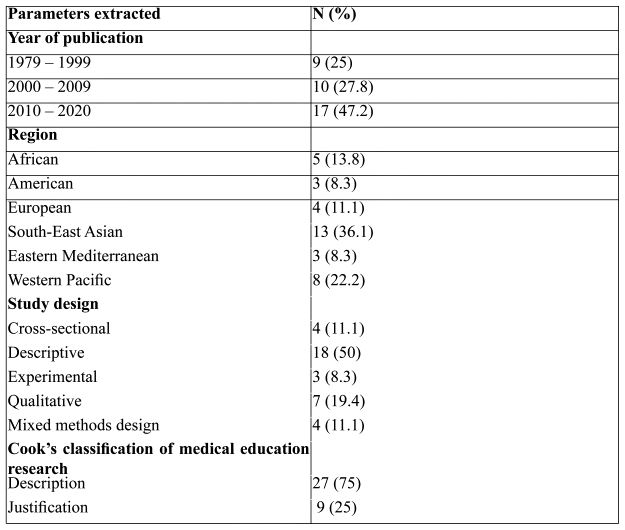
The curriculum details are organized under the following headings: (i) Learning Objectives; (ii) Duration and Trainer; (iii) Learning Environment and Teaching-Learning Methods; and (iv) Assessment.
The CBME content delivered to learners included all domains of learning, namely cognition, attitude, and skills. Among the cognitive components taught, 55.6% belonged to generating awareness of commonly prevailing health problems in the community and 36.1% to clinical reasoning. Among the attitude-related content, 27.8% were on teamwork, and six studies (16.6%) mentioned leadership and social accountability. The major psychomotor domain of learning was the assessment of socio-cultural determinants (55.5%) and training on clinical skills (47.2%). Seven (19.4%) mentioned teaching research skills through CBME (Table 2).3,5,14,15
Table 2 Details of undergraduate CBME curriculum for included studies of review (N=36).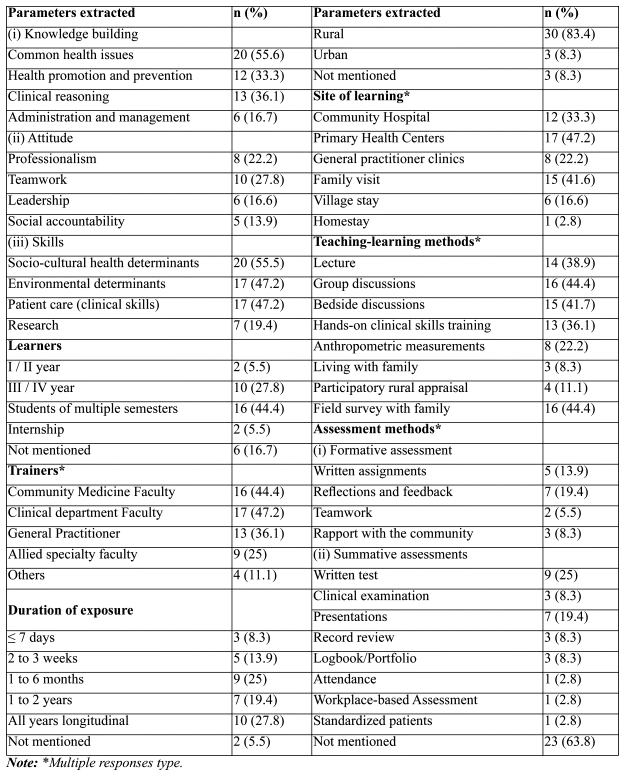
Medical undergraduates of all semesters were taught CBME. Among them, 44.4% were taught throughout the course at multiple semesters, and 27.8% were taught during the III or IV years of the course. Two studies (7.1 %) reported that the target learners were medical interns.16,34 A medical school in Nigeria described that in their Community-Based Education and Service, (COBES) program, exposure to CBE started from the very first week of their course and it extended in blocks throughout their course.40 Medical college faculties were the major trainers of students on CBME. Among them, 47.2% were taught by clinical specialty faculty and 44.4% by Community and Family Medicine department faculty. Allied specialty faculty were part of CBE in 25% of the studies and a study from South Africa reported that they involved interprofessional teams to teach CBE.15 Most (83.4%) of the CBME was delivered in rural settings. Students were exposed longitudinally from the first to the last year of the course in 27.8% of the studies included (Table 2).
Students were posted in a variety of community-based settings for learning. Among them, the Primary Health Centre (47.2%) was the majority site of posting. Family visits happened in 41.6% of the studies and general practitioner clinics and community-based hospitals (22.2% each) were the other common sites of exposure. Six (17.9%) studies reported village stay,3,5,16,20,23,40 and one study had homestay as a means of learning in a community setting.27
Of the various teaching-learning methods involved, 16 studies (44.4%) mentioned group discussions and field surveys as methods of training. Bedside discussions happened in 41.7% of them. Hands-on skills training and lectures were used among 36.1% and 38.9% of the included studies.
The assessment methods involved were not reported by (67.9%) majority of the studies. The most reported formative assessment method was reflections and feedback (19.4%) followed by written assignments (13.9%). The most reported summative assessment was a written test (25%) followed by presentations of the learning experience (19.4%). The other reported methods of assessment were clinical examination (8.3%), record review (8.3%), logbook evaluation (5.5%), and portfolio (2.8%). The CBE curriculum of Brazil has included Workplace-based Assessment using Mini-CEX and Direct Observation of Procedural Skills.15 (Table 2).
The reported challenges in designing and implementing CBME were organized into three themes, namely student and educator-related, community-related, and administration-related. The common learner-related challenges were poor attitude towards CBE; lack of continuity in care to family by students; difficulty adapting to the new learning environment; and inadequate expected knowledge and skills. The challenges from the educator's side were deficiency in their pedagogical skills and technical literacy; difficulty in using newer assessment tools; and insufficient integration of clinical subjects into CBE.
Community-related challenges were reluctance to accept the program; the level of engagement of the community; field workforce shortage; arrangement of security measures; site selection and placement; persuading community leaders; family perception towards the medical school; and language barrier. Administration-related issues were mainly political and financial, including difficulty in obtaining permission from the Municipal and Local Health Council; lack of funding; no incentives to trainers; reputation status of the school; cooperation between the institute and local health system; limited hospital resources; lack of transport facility; inadequate policy and program level changes; and non-availability of scholarship for higher studies in primary care (Figure-2).
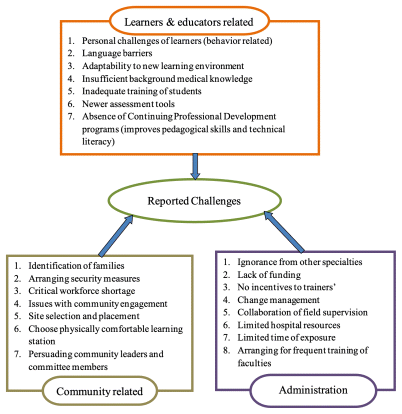
Figure 2 Reported challenges/barriers in the implementation of CBME
The interviewed stakeholders were mainly students and educators. Two studies explored the perceptions of community members, and one study interviewed administrators. Almost all studies (except one) reported positive attitudes of all stakeholders towards CBME and enriching learning experiences by students.21 The manual content analysis of perceptions and outcomes of CBME was performed by the authors and they were grouped under five categories, namely attitude toward learning the subject; various aspects of learning; career influence; learning strategies; and community participation. Positive attitude to work in rural settings was reported in three studies.22,23,41 The other details are mentioned in Table 3.
Table 3 Content analysis of stakeholder’s reported perception and impact of CBME.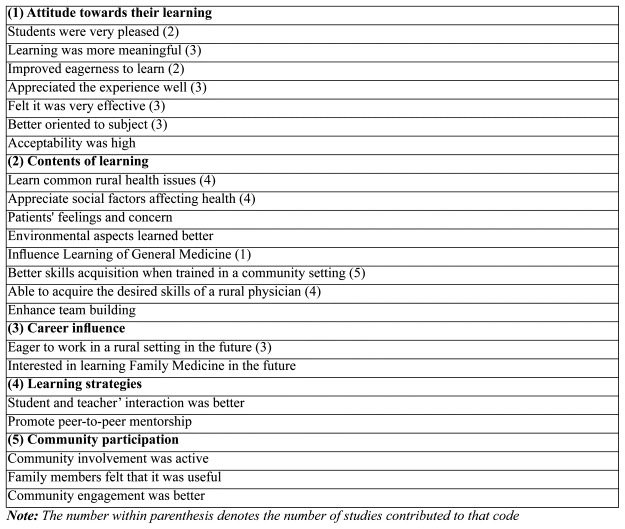
There were only three studies that evaluated the long-term impact of CBME.25,31,42 Their results conveyed that there was no improvement in knowledge score between traditional and CBME modes of teaching however there was a positive change in attitude towards learning in a community setting,25 and the model had cost-neutral to small positive financial benefits.31 The difference in intensity of training in a community setting had no significant change in the knowledge, attitude, and skills of the learners.42
The current scoping review on the CBME program was based on 36 previously published global studies. These studies happened in diverse locations and adopted diverse study designs; thus it was more suitable for a scoping review than a systematic one. Nearly 50% of the included studies were published in the last 10 years, 33% took place in Southeast Asia, and 75% were descriptive studies. Almost 80% of the program was in rural settings. Nearly 40% of the models were run in multiple semesters at PHCs and 25% were longitudinal. Almost all studies reported positive attitudes of all stakeholders towards CBME and the enriching learning experiences by students.
In the spectrum of Community-Based Education, the majority were service-oriented CBME category with one truly engaging and empowering the community.14 Despite being CBME-oriented, the essential curriculum elements, namely teaching, learning activities, and assessment, are not consistent across studies. This review revealed numerous differences in CBME implementation that happened in the Western Pacific region and India. In India, the exposure to CBME tends to be of shorter duration, with limited interprofessional teams and assessment predominantly occurs in a classroom setting.3–5,16,19
Harden suggested educational strategies in curriculum development, the SPICES model primarily supports CBME.43 Scaling up community exposure and training for undergraduate students has the potential to improve the health outcomes and learning of students.44,45 Amidst the existence of varied levels of cognitive ability and motivation of students, and differences in the level of training and interest of teachers in various public and private medical institutes, the National Medical Commission (NMC) aims to have longitudinal, fixed hours and methods of training in the community for the undergraduates. This is now mentioned in the new competency-based curriculum.46
In India, the trainers of CBME were mainly faculties of Community Medicine and it is mainly imparted through their department.3–5,16,19 Studies done in other regions involved faculties from allied health specialties, namely physiotherapists, occupational therapists, speech pathologists, cultural consultants, etc.20,25,28,42 The involvement of an inter-professional team for CBME has the potential to foster improved relationships between underserved communities, hospitals, and medical universities. It improves communication skills and empathy, thereby has the potential to reduce doctorpatient violence and improve health outcomes.47
Our review discovered that most of the studies have not reported their assessment methods. Only a few had formative assessments in the form of feedback from the community.4,19,26 Most of the reported summative assessments happened in a classroom setting using traditional written methods. Students can rapidly acquire competencies and confidence in primary care when the assessment happens in a community setting.48 Hence any CBME program needs to adopt a comprehensive approach to student assessment in community settings using multiple methods by multiple assessors and at multiple time points. Peer assessment, supervisory checklist, community feedback, reports from students, reflective narrations, Objective Structured Clinical Examination, etc., all need to be explored.
For assessing the impact of such a program, indicators related to various stakeholders, namely students, institute, community, and country, need to be devised and utilized.49 Student-level indicators could be changes in their skill, attitudes, communication, and ethical values, apart from the knowledge that needs to be assessed periodically rather than at the immediate end of the program. Community-level indicators could be the level of community engagement, health care utilization, morbidity and mortality indicators, etc. Institute-level indicators could be the level of students’ and parents’ satisfaction, enrollment rate, stability of teachers, publications, etc. Country-level indicators could be rural-urban disparity, morbidity and mortality indicators, universal health coverage, etc.
In India, the Re-Orientation of Medical Education (ROME) program initially sought to implement CBE in line with the recommendations from the 48th World Health Assembly. However, its application was limited to specific institutions and has largely ceased.50 The Unnat Bharat Abhiyan program which is currently governed by the Ministry of Education, motivates medical students to engage in the sustainable development of adopted villages.51 More recently, the National Medical Commission (NMC) rolled out the Family Adoption Program (FAP) curriculum for medical undergraduates, requiring each student to oversee the healthcare of at least five families.52 This expansion in CBME opportunities in India highlights the need for an effective and holistic curriculum that addresses local community needs. In designing a CBME program, it is crucial to consider various factors including the location, duration, student capacity, availability of learning resources, suitable teaching methods, support for staff and students, community-focused assessment strategies, and financial implications.
CBE is recognized as a way to achieve educational relevance to community needs and its learning activities require extensive utilization of the community field sites. However, when it comes to implementation, factors at the country, community, regional, institutional, educator, and learner level influence diversity and difficulty. Involving the community could streamline the logistical aspects, and community-based barriers of running CBME by actively engaging them in teaching, mobilizing for health education, and other student-related activities.6,12 For medical education programs to be capable of producing health professionals who are available to improve access to health care, who are competent to improve the health outcomes of the population, and who could avert the current health care challenges of society, the implementation of CBME needed to take place in its true sense—demanding strategic and sustainable change in institutional structure, curriculum and faculty, resource allocation and commitment at all levels.
The chosen study design aligned well with our research inquiries. We implemented a methodological framework and structured reporting in the article selection process using a flow diagram, enhancing the internal validity of our review findings. However, our study did have a few limitations: Firstly, we included a wide range of study designs, methodologies, and populations. This heterogeneity makes it difficult to synthesize findings across studies and may lead to a less coherent overall picture of the research landscape. Secondly, there might have been some studies related to CBME that weren't captured, a common issue in scoping reviews. Nonetheless, we employed a systematic approach to data retrieval to mitigate this. Notably, among the selected studies, there was a strong emphasis on extracting relevant data on CBME.
Globally, CBME curricula demonstrate a range of components. In Western nations, CBME spans multiple phases of courses, involves interdisciplinary training teams, and incorporates teaching at primary health centers. However, in the Indian context, CBME exposure tends to be brief, primarily conducted by the Community Medicine department through family surveys, with assessments commonly held in a classroom setting. Notably, none of the reviewed studies mentioned community involvement in curriculum design, implementation, or evaluation. Virtually every study noted a favorable outlook among all stakeholders toward CBME, along with students reporting an enhanced learning experience. Recognizing the variations in CBME curricula implemented worldwide enables academicians to create an effective, comprehensive curriculum tailored to the socio-cultural context and the specific needs of the local community.
1. Bassett MT. Health for All in the 21st Century. American Journal of Public Health 2006;96(12):2089–2089. https://doi.org/10.2105/AJPH.2006.102533
Crossref
2. Magzoub MEMA, Schmidt HG. A Taxonomy of Community-based Medical Education. Academic Medicine 2000;75(7):699–707. https://doi.org/10.1097/00001888-200007000-00011
Crossref PubMed
3. Joseph A, Abraham S. Community-oriented medical education in Vellore, India. Academic Medicine 1993;68(5):336–339. https://doi.org/10.1097/00001888-199305000-00005
Crossref PubMed
4. Goswami K, Salve H, Malhotra S, Kumar Y. Critical Review of “Family Health Advisory Services” Assessment in MBBS Training Program in Community Medicine. International Journal of Applied and Basic Medical Research 2017;7(Suppl 1):S27–S32. https://doi.org/10.4103/ijabmr.IJABMR_155_17
Crossref
5. Garg BS, Raut A. Community based medical education at Mahatma Gandhi Institute of Medical Sciences, Sevagram - a Gandhian way to achieve social accountability of an academic institute. Indian Journal of Community and Family Medicine 2016;2(2):33. https://doi.org/10.4103/2395-2113.251818
Crossref
6. Omotara BA, Padonu MO, Yahya SJ. Assessment of the impact of community-based medical education of the University of Maiduguri on communities in three local government areas of Borno State, Nigeria: community leaders’ perspectives. Education for Health 2004;17(1):6–16. https://doi.org/10.1080/13576280310001656114
Crossref PubMed
7. Boelen C, Heck JE. Defining and measuring the social accountability of medical schools. World Health Organization. 1995. Available from: https://apps.who.int/iris/handle/10665/59441. Accessed August 2024.
8. Garg B, Nair S. Doctors for the rural poor. World Health Forum 1996;17:268–70. https://iris.who.int/bitstream/handle/10665/53957/WHF_1996_17(3)_p268-270.pdf?sequence=1. Accessed October 2024.
PubMed
9. Daudt HM, van Mossel C, Scott SJ. Enhancing the scoping study methodology: a large, inter-professional team’s experience with Arksey and O’Malley’s framework. BioMed Central-Medical Research Methodology 2013;13(1):48. https://doi.org/10.1186/1471-2288-13-48
Crossref
10. Arksey H, O’Malley L. Scoping studies: towards a methodological framework. International Journal of Social Research Methodology 2005;8(1):19–32. https://doi.org/10.1080/1364557032000119616
Crossref
11. Tricco AC, Lillie E, Zarin W, O’Brien KK, Colquhoun H, Levac D, et al. PRISMA Extension for Scoping Reviews (PRISMA-ScR): Checklist and Explanation. Annals of Internal Medicine 2018;169(7):467–473. https://doi.org/10.7326/M18-0850
Crossref PubMed
12. Strasser R, Worley P, Cristobal F, Marsh DC, Berry S, Strasser S, et al. Putting communities in the driver’s seat: the realities of community-engaged medical education. Academic Medicine 2015;90(11):1466–1470. https://doi.org/10.1097/ACM.0000000000000765
Crossref PubMed
13. Dent. A Practical Guide for Medical Teachers. 4th edition. London; New York: Elsevier Health - UK; 2013. ISBN: 978-0-7020-4551-6.
14. Neufeld, Victor, Sitthi-amom C, White K. Priority Health Problems in Medical Education. Network of community-oriented educational institutions for Health Sciences Task Force II; 1990. Available from: https://idl-bnc-idrc.dspacedirect.org/server/api/core/bitstreams/0a01df65-f82c-4365-a889-4c9027788129/content. Accessed October 2024.
15. Talaat W, Ladhani Z. Community Based Education in Health Professions: Global Perspectives Regional Office for the Eastern Mediterranean. 2014. ISBN: 978-92-9021-991-0. https://www.researchgate.net/publication/335722949. Accessed October 2024.
16. Dongre A, Deshmukh P, Garg B. Formative exploration of students’ perception about Community Medicine teaching at Mahatma Gandhi Institute of Medical Sciences, Sewagram, India. Online Journal of Health Allied Sciences 2008;7. https://www.researchgate.net/publication/36448284. Accessed March 2024.
17. Dongre A, Deshmukh P, Garg B. Portfolio based approach for teaching Community Medicine among medical undergraduates and assessment of their learning in a medical college in rural India. South-East Asian Journal of Medical Education 2010;1741. https://doi.org/10.4038/seajme.v4i1.434
18. Dongre AR, Deshmukh PR, Gupta SS, Garg BS. An evaluation of ROME Camp: forgotten innovation in medical education. Education for Health 2010;23(1):363. https://doi.org/10.4103/1357-6283.101501
Crossref PubMed
19. Ganapathy K, Dongre A. Process of Developing of Community Based Medical Education Programme Curriculum in Puducherry, India. Journal Of Clinical And Diagnostic Research 2018;12. https://doi.org/10.7860/JCDR/2018/32334.11383
20. Choulagai BP. Community-based education in the Institute of Medicine, Tribhuvan University, Nepal: a qualitative assessment. Advances in Medical Education and Practice 2019;10:469–478. https://doi.org/10.2147/AMEP.S171377
Crossref
21. Sharma AK, Yadav BK, Pramod GC, Paudel IS, Chapagain ML, Koirala S. Community-based medical education: The Nepal experience. Indian Journal of Community Medicine 2007;32(3):195. https://doi.org/10.4103/0970-0218.36826
Crossref
22. Somporn P, Walters L, Ash J. Expectations of rural community-based medical education: a case study from Thailand. Rural and Remote Health 2018;18(4):4709. https://doi.org/10.22605/RRH4709
PubMed
23. Singh US. Rural Stay Exposure for Undergraduate Medical Student. National Journal of Community Medicine 2011;2(3):320–1. https://www.researchgate.net/publication/265490237. Accessed November 2023.
24. Zabidi H, Fuad AR. Medical education in Universiti Sains Malaysia. The Medical Journal of Malaysia 2002;57 Suppl E:8–12. PMID: 12733185. https://pubmed.ncbi.nlm.nih.gov/12733185/ Accessed March 2024.
PubMed
25. Mahoney S, Walters L, Ash J. Urban community based medical education - general practice at the core of a new approach to teaching medical students. Australian Family Physician 2012;41(8):631–6. https://www.researchgate.net/publication/233397541. Accessed March 2024.
PubMed
26. Morgan S, Smedts A, Campbell N, Sager R, Lowe M, Strasser S. From the bush to the big smoke--development of a hybrid urban community based medical education program in the Northern Territory, Australia. Rural and Remote Health 2009;9(3):1175. https://doi.org/10.22605/RRH1175
PubMed
27. Kenzaka T, Yahata S, Goda K, Kumabe A, Akita H, Okayama M. Acceptance of a homestay program and attitude toward community medicine among medical students. PLOS One 2020;15(9):e0238820. https://doi.org/10.1371/journal.pone.0238820
Crossref PubMed PMC
28. Ohta R, Son D. What do medical residents learn on a rural Japanese island? Journal of Rural Medicine 2018;13(1):11–17. https://doi.org/10.2185/jrm.2950
Crossref PubMed PMC
29. Ohta R, Ryu Y, Katsube T, Moriwaki Y, Otani J. Students’ perceptions of general medicine following community-based medical education in rural Japan. Journal of General and Family Medicine 2019;20(6):236–243. https://doi.org/10.1002/jgf2.274
Crossref PubMed PMC
30. Birden H, Wilson I. Rural placements are effective for teaching medicine in Australia: evaluation of a cohort of students studying in rural placements. Rural and Remote Health 2012;12(4):1–13. https://doi.org/10.22605/RRH2167
31. Hudson JN, Weston KM, Farmer EA. Medical students on long-term regional and rural placements: what is the financial cost to supervisors? Rural and Remote Health 2012;12(2):1951. https://doi.org/10.22605/RRH1951
PubMed
32. Strasser RP. Community engagement: a key to successful rural clinical education. Rural and Remote Health 2010;10(3):1543. https://doi.org/10.22605/RRH1543
PubMed
33. Kaufman A, Mennin S, Waterman R, Duban S, Hansbarger C, Silverblatt H, et al. The New Mexico experiment: educational innovation and institutional change. Academic Medicine 1989;64(6):285–294. https://doi.org/10.1097/00001888-198906000-00001
Crossref PubMed
34. Ali A. Community-oriented medical education and clinical training: comparison by medical students in hospitals. Journal of the College of Physicians and Surgeons Pakistan 2012;22(10):622–626. https://doi.org/10.2012/JCPSP.622626
PubMed
35. Thistlethwaite JE. Introducing community-based teaching of third year medical students: outcomes of a pilot project one year later and implications for managing change. Education for Health 2000;13(1):53–62. https://doi.org/10.1080/135762800110574
Crossref
36. Howe A. Patient-centred medicine through student-centred teaching: a student perspective on the key impacts of community-based learning in undergraduate medical education. Medical Education 2001;35(7):666–72. https://doi.org/10.1046/j.1365-2923.2001.00925.x
Crossref PubMed
37. Adefuye A, Benedict M, Bezuidenhout J, Busari JO. Students’ Perspectives of a Community-Based Medical Education Programme in a Rural District Hospital. Journal of Medical Education and Curricular Development 2019;6:2382120519886849. https://doi.org/10.1177/2382120519886849
Crossref
38. Wakida EK, Ruzaaza G, Muggaga K, Akera P, Oria H, Kiguli S. Health-profession students’ teaching and learning expectations in Ugandan medical schools: pre-and post community placement comparison. Advances in Medical Education and Practice 2015;6:641–56. https://doi.org/10.2147/AMEP.S91624
Crossref
39. Kristina TN, Majoor GD, van der Vleuten CPM. Comparison of outcomes of a community-based education programme executed with and without active community involvement. Medical Education 2006;40(8):798–806. https://doi.org/10.1111/j.1365-2929.2006.02526.x
Crossref PubMed
40. Hamilton JD, Ogunbode O. Medical education in the community: a Nigerian experience. Lancet 1991;338(8759):99–102. https://doi.org/10.1016/0140-6736(91)90087-6.
Crossref PubMed
41. Howe A, Ives G. Does community-based experience alter career preference? New evidence from a prospective longitudinal cohort study of undergraduate medical students. Medical Education 2001;35(4):391–7. https://doi.org/10.1046/j.1365-2923.2001.00866.x
Crossref PubMed
42. Azizi F. Evaluation of the community-oriented medical education in two medical schools in Sudan. Eastern Mediterranean Health Journal 2003;9(1):191–200. https://doi.org/10.26719/2003.9.1-2.191
Crossref
43. Harden RM, Sowden S, Dunn WR. Educational strategies in curriculum development: the SPICES model. Medical Education 1984;18(4):284–97. https://doi.org/10.1111/j.1365-2923.1984.tb01024.x
Crossref PubMed
44. Crampton PES, McLachlan JC, Illing JC. A systematic literature review of undergraduate clinical placements in underserved areas. Medical Education 2013;47(10):969–78. https://doi.org/10.1111/medu.12215
Crossref PubMed
45. Denz-Penhey H, Shannon S, Murdoch CJ, Newbury JW. Do benefits accrue from longer rotations for students in Rural Clinical Schools? Rural and Remote Health 2005;5(2):414. https://doi.org/10.22605/RRH414
PubMed
46. National Medical Commission. UG Curriculum | NMC. Available from: https://www.nmc.org.in/information-desk/for-colleges/ug-curriculum. Accessed May 2023.
47. Reeves S, Perrier L, Goldman J, Freeth D, Zwarenstein M. Interprofessional education: effects on professional practice and healthcare outcomes. The Cochrane Database of Systematic Reviews 2013(3). DOI: 10.1002/14651858.CD002213.pub3.
Crossref
48. Maley M, Worley P, Dent J. Using rural and remote settings in the undergraduate medical curriculum: AMEE Guide No. 47. Medical Teacher 2009;31(11):969–83. https://doi.org/10.3109/01421590903111234
Crossref PubMed
49. Molenaar WM, Zanting A, van Beukelen P, de Grave W, Baane JA, Bustraan JA, et al. A framework of teaching competencies across the medical education continuum. Medical Teacher 2009;31(5):390–6. https://doi.org/10.1080/01421590902845881
Crossref PubMed
50. World Health Assembly 48. Reorientating medical education and medical practice for health for all. 1995. Available from: https://iris.who.int/handle/10665/178404. Accessed December 2023.
51. Unnat Bharat Abhiyan | inspired by the vision of transformational change in rural development processes by leveraging knowledge institutions. Available from: https://unnatbharatabhiyan.gov.in/introduction. Accessed November 2023.
52. Yalamanchili VK, Uthakalla VK, Naidana SP, Kalapala A, Venkata PK, Yendapu R. Family Adoption Programme for Medical Undergraduates in India – The Way Ahead: A Qualitative Exploration of Stakeholders’ Perceptions. Indian Journal of Community Medicine 2023;48(1):142–6. https://doi.org/10.4103/ijcm.ijcm_831_22
Crossref PubMed PMC
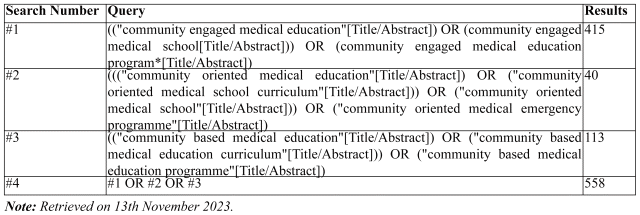
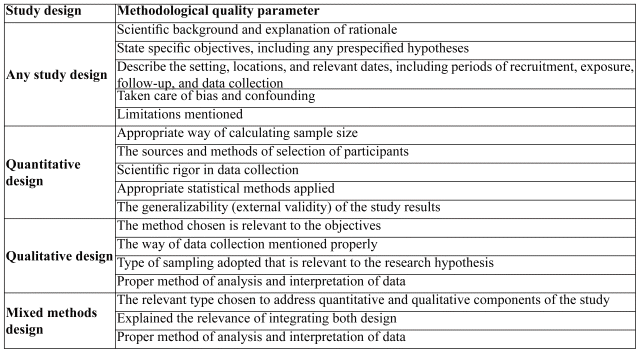
© Education for Health.
Education for Health | Volume 37, No. 4, October-December 2024